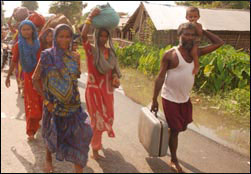Gender-based violence and environment linkages
<p>Around the world, it is estimated that one in three women and girls will experience gender-based violence (GBV) during her lifetime (World Bank, 2019). Rooted in discriminatory gender norms and laws
<p>Around the world, it is estimated that one in three women and girls will experience gender-based violence (GBV) during her lifetime (World Bank, 2019). Rooted in discriminatory gender norms and laws
This guide helps us to better understand the role of MPAs and MPA networks at local and regional scales to achieve marine conservation. It utilizes current scientific knowledge, institutional experience and global case studies to outline the latest information pertaining to building resilient and functional MPA networks. It also highlights global commitments
Despite the growing awareness of the nexus between climate change and migration the subject has not been explored empirically in a way that generates conclusive results.

This short book analyzes the prospect of large-scale forced migration as a result of climate change and attempts to estimate the developmental impact of potentially millions of people displaced by coastal flooding, extreme weather events and agricultural disruption.
Living planet report 2008 looks at the cause and effect relationships which determine the Earth's health. Key to the report is the Living Planet Index, used to map out the state of the world's ecosystems, and the Ecological Footprint.

WWF presented a series of case studies from four continents showing that measures to improve the health of stressed water systems now would also improve their ability to cope with projected climate impacts in the future. This report shows that practical adaptations to climate change impacts on freshwaters may have immediate benefits for peoples' livelihoods and to conserve ecosystems, and should be priorities for governments and aid donors.
Climate adaptation is the process of adjusting to novel climate regimes, such as reducing water consumption to compensate for reduced precipitation rates, shifting the location of an industry away from an increasingly drought-prone area to a region that will be receiving higher flows, or altering urban stream morphology to allow for larger and more frequent floods.
Coal is abundant and affordable in the Asia Pacific region, and for the foreseeable future could be used to meet the region's growing energy needs, but what becomes of those needs when air is too dirty to breathe; water is too polluted to drink; soil too contaminated to grow crops; land is unfit for habitation; and global warming unleashes unimaginable environmental disasters?

This publication provides an overview of key facts and societal challenges related to economic development, future energy demand and the impact that demand could have on the climate system.The focus of this publication is on the world's use of energy and its related impacts.

This publication is focused on providing an overview of adaptation from a business perspective. It describes potential impacts of climate changes, risks and opportunities for business, and why business should consider adaptation planning and measures.